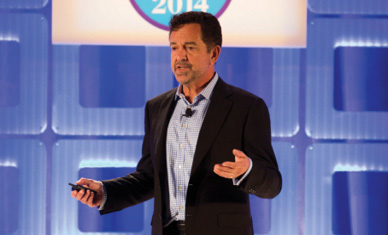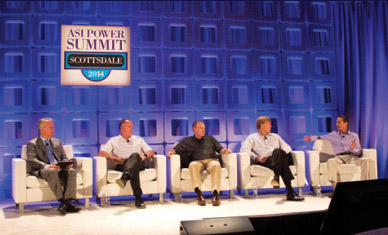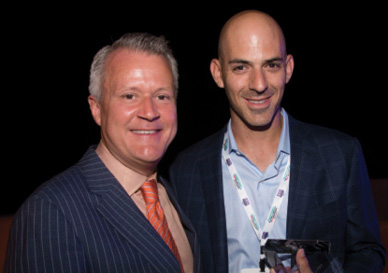Awards October 14, 2014
2014 - ASI Power Summit
The ad specialty industry’s top influencers gathered in Arizona last month to set a course for the market, share best practices and debate their top challenges. Here’s a recap of the three-day conference.
With an eye toward the future, ASI hosted its annual Power Summit last month in Arizona. Held at the Four Seasons Resort Scottsdale, the three-day conference brought together the ad specialty industry’s leading executives to discuss the challenges of the business today – and to look ahead to what’s in store for the market moving forward.
And moving forward was clearly on the agenda. With sessions focused on future predictions, economic outlooks, new strategies that will take shape in the coming years, and even new technologies that will dictate new approaches to business, the conference gave attendees a look into how their operations may soon change.

In fact, two demonstrations from local companies showed Power Summit attendees exactly how drone technology can be used for deliveries (yes, still a while away, but Amazon.com is already testing it) and, even sooner, how they can be implemented into warehouse inventory management and overall marketing plans. In all, it was three days packed with forward-thinking information.
Keep reading to take a look at some of the images and content that was discussed. And, go to www.counselormag.com to see video interviews with speakers and more pictures from the conference.
Forecast: Industry Sales to Reach $40 Billion by 2020
With the theme of the ASI Power Summit focused on the future and what industry companies will need to do – and be aware of – in the coming years to succeed, one of the main sessions of the conference was called “Meet the Future.” During the session, strategist John Smart detailed several predictive trends to help ad specialty companies plan for the next year and beyond.

Smart theorized that the evolution of the Internet, better machines and improving social networks will catapult the ad specialty industry to nearly $40 billion in annual sales by 2020. How exactly will it happen? Revenues will jump as firms move away from pushing content and ads, and instead leverage pull marketing – the concept of drawing customers to you.
“You become successful as a company when you have a story that makes you unique,” Smart said. “Companies need to develop and sell products that are beautiful, useful and sustainable.”
While he highlighted the power of innovation, Smart downplayed the short-term impacts of 3-D printing, drone technology and holograms. He instead encouraged companies to invest in e-commerce and mobile platforms, while promoting cognitive diversity – a balance of certain traits – among employees.
Forbes Publisher Offers Economic Outlook
“The U.S. economy is not having a spectacular rebound,” Rich Karlgaard, publisher of Forbes magazine, said during the ASI Power Summit’s keynote session. While in past non-recessionary times, the economy has enjoyed GDP growth of 3%-4% or better, the country is stuck at about 2% right now.
How can small companies beat the odds and grow at a faster pace? “Good strategy and execution will keep you plugging along,” he said. But to really enjoy growth, companies must focus on the “soft edge,” Karlgaard said, meaning qualities that are less measurable but equally important, like corporate culture and teamwork.
Corporate leaders who are hard-nosed strategists but don’t have good interpersonal or communication skills, for example, should recognize that and hire or promote leaders who have those qualities. “Bring in your cognitive opposite to handle what you’re lacking,” he said. As an example, Karlgaard said, Starbucks initially struggled as a smaller company, until founder Howard Schultz brought in Howard Behar (now former president of the company), who focused on “worrying about making every Starbucks in the world feel magical.”
“We talk a lot about diversity in hiring, but we usually mean diversity in age or race,” he said. “We also need to talk about cognitive diversity – bringing people on board who bring different solutions to your organization.”
The Need for Speed
As business gets faster every day, the ad specialty industry is not immune. In fact, much of the talk among panelists and attendees at the Power Summit was based around how the industry can become faster in fulfilling orders and responding to – as well as anticipating – customer requests. In a panel discussion led by ASI President and CEO Tim Andrews and kicked off by a special demonstration of drone technology, four industry experts discussed what suppliers and distributors need to do to meet this growing demand for faster service, order processing, and more.
Jim Epstein of Polyconcept North America said he sees more orders being turned around 24 to 48 hours after being received, which is reflective of more businesses adopting a program model with clients. Rather than the traditional model of selling the product to a client and then buying it, distributors are buying the product (which suppliers are holding in inventory) and then selling it to clients. This change, according to Vantage Apparel’s (asi/93390) Ira Neaman, makes the process more efficient for all parties involved. In the program model, the order can be turned quicker.
And while that is true for apparel and other hard goods, when it comes to custom products, speed comes at a price. In fact, Mike Emoff of distributor firm Shumsky (asi/326300) said that the cost can be four times greater when it comes to a custom order. But speed can be a matter of cleaning up the order process, according to the session’s panelists. Alan Vaught of Evans Manufacturing (asi/52840) said that if a clean order comes through, one that does not require proofs, it can be in production within 15 minutes of receiving the order. And, according to Neaman, even if an order hasn’t been finalized, Vantage can allocate the products and hold them until everything is ready to go.
Executives in the industry, though, believe companies in this market are doing well so far with the speed of their operations. While the need for quicker order procurement dominated discussion, the audience thought the industry is doing well with its speed today. When asked if the industry’s speed was fast enough, a vote via text message revealed that 66% of the audience said “yes’ while 34% said “no.”
Zappos Reveals Customer Service Success Secrets
Not only do companies need to think progressively today when it comes to their operations and sales strategies, but they also need new approaches to how they deal with customers. The highlight of the “Build A Better Culture Of Customer Service” session during the ASI Power Summit was insight from Tami Lemke, a customer service supervisor with online shoe and clothing seller Zappos, which is hailed as one of the best providers of customer service today.
The session started with an audience poll. Attendees were asked how they rated customer service in the industry. The majority (65%) give it a grade of A/B, while 35% rated it a C/D/F. At Zappos, Lemke said, reps are empowered to do what’s necessary to keep customers happy. There are no sales quotas or talk-time restrictions, and if something goes awry, reps can offer Wow Packages which include coupons or discounts or even tins of cookies or flower bouquets. In fact, she said they often send flowers after a customer has passed away. Those personal connections are what endear Zappos to its customers. In addition, each rep takes 15 minutes every day to write out cards to customers. Some draw pictures, others write poems, and each week someone wins the Whiz Bang Card of the Week Award.
Recognition comes in other forms, too. “We actually have a Hero Award and a Manager of the Month Award,” Lemke said. “And, we also have a Sidekick Award which goes along with the Hero Award.” Not only is the recognition appreciated, but it goes a long way toward solidifying the customer service culture that’s prevalent at the company.
Heroes, Lemke explained, have leeway to solve problems – lost items, items never showing up, defective items, etc. – how they see fit without fear of management second-guessing the decision. In one example, a Hero was trying to help a little girl with leukemia who wanted a pair of shoes the company didn’t sell. The rep wanted to buy them from another company, but the customer service manager talked to the kids’ shoes department and together they crafted a package that included promotional items from vendors, a handwritten card, shoes, and more. And even though she didn’t get the shoes she originally wanted, she got an experience she never could have imagined.
But the customer service culture at Zappos is not limited to the reps who work the phones. It is the core of the company. Every employee receives customer service training and they answer phones for four weeks before they are trained in the job they were hired to do. And everyone does it, including CEO Tony Hsieh, who once accidentally hung up on a customer only to call her back and offer her coupons. “Culture is everyone’s responsibility,” Lemke said.
The Benefits of Unorthodox Marketing
In the highest-rated of the Power Summit’s sessions, Cal McAllister, CEO of Seattle-based ad agency Wexley School for Girls, encouraged attendees to take risks in marketing. His overall message to a riveted audience: live on the leading edge of creativity in promotions so that you (and your clients) stand out in the crowded marketing world.
Throughout his session, titled “Unorthodox Marketing: Why It Works,” McAllister showcased several case studies of Wexley’s top campaigns – which stood out by using video skits, snow-making machines, elaborate building projections, and even ad specialties in unique ways. The key, according to McAllister? Don’t be safe today. Be willing to push the limits of what your clients expect, otherwise you’ll simply be providing the same services as everybody else.
With clients ranging from professional sports teams Seattle Sounders and Seattle Seahawks to major brands such as Nike, Microsoft and T-Mobile, McAllister detailed how his agency tries to turn advertising and marketing campaigns into fun, must-see events. To McAllister, the success of marketing and promotional campaigns is based on whether they’re memorable, as well as how much customers want to interact with them. Ultimately, he said, if you can create experiences that get your clients’ customers to interact with their brand in a positive way, then you’ll break out from the crowd.
Power 50 Panel Looks to 2015
In the final 2014 Power Summit session, four of the industry’s most influential leaders offered their views on the current ad specialty market and on the 12 months ahead. Much of the discussion centered on the topics of consolidation, sourcing, margin pressures, and rapidly evolving technologies.

“After hearing the futurist talk this week, I realize we have some work to do as a company,” said Bill Korowitz, CEO of supplier The Magnet Group (asi/68507). “We need to make even more tech improvements. We’ll get there.”
Kim Newell, another panelist, spoke extensively about mergers and partnerships. In the years ahead, she feels more suppliers especially will combine strengths to better serve customers. “We recently made the deal with Gold Bond (asi/57653) and it was attractive to us because they have a physical presence in China and we don’t,” said Newell, president of World Wine Line (asi/98290). “I think you’ll see companies partnering in the future.”
Alan Chippindale, a third panelist and the chief business development officer at distributor BrandAlliance (asi/145177), said he continues to see growth opportunities in large accounts.
Meanwhile, panelist Dave Thompson is gearing his firm’s strategy toward smaller customers. “We target small businesses and our average order size is $200,” said Thompson, president of National Pen (asi/281040). “We are expanding globally, though, with this model. In fact, in 17 days we’re even going to try to sell to small businesses in China.”
